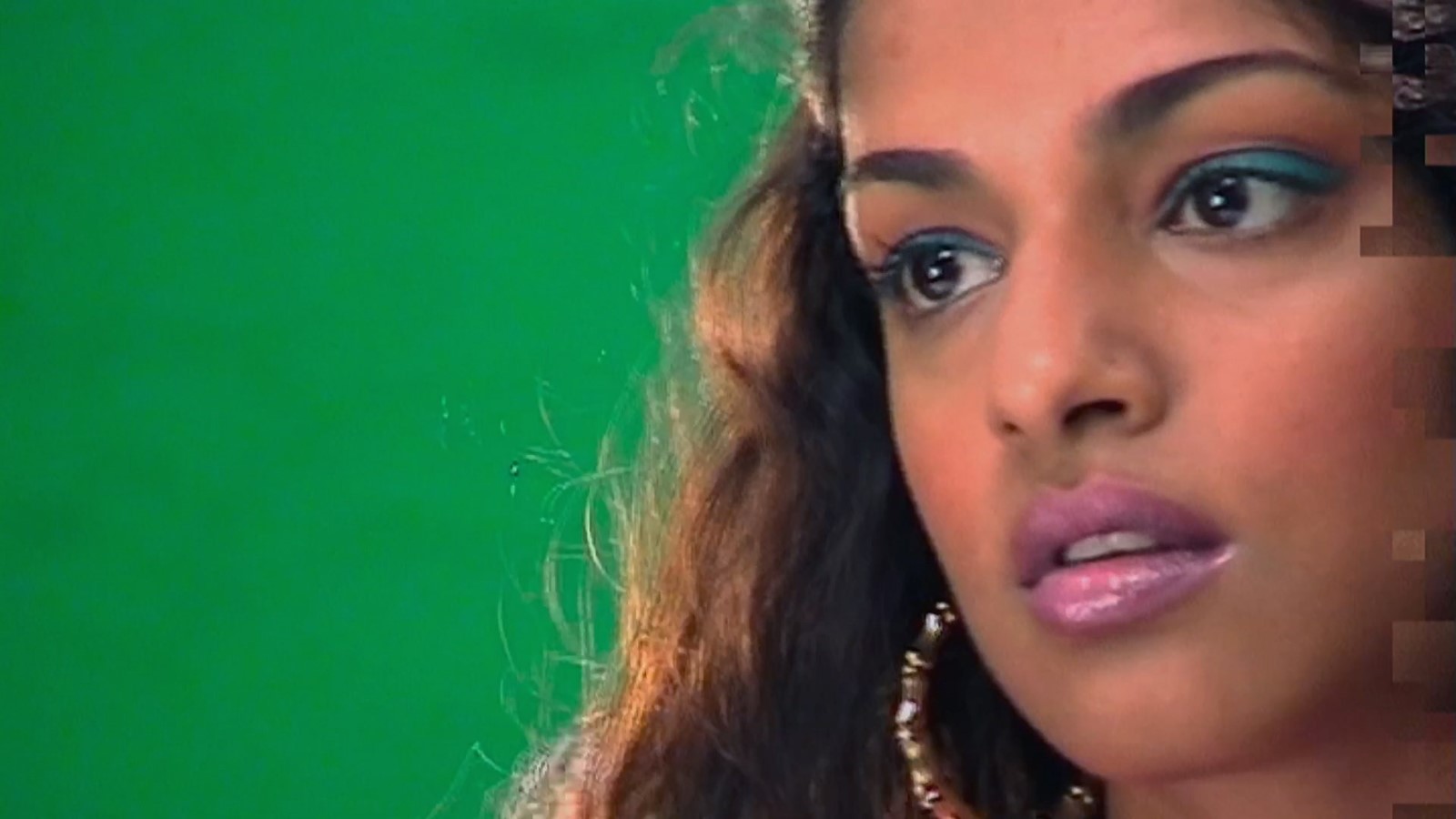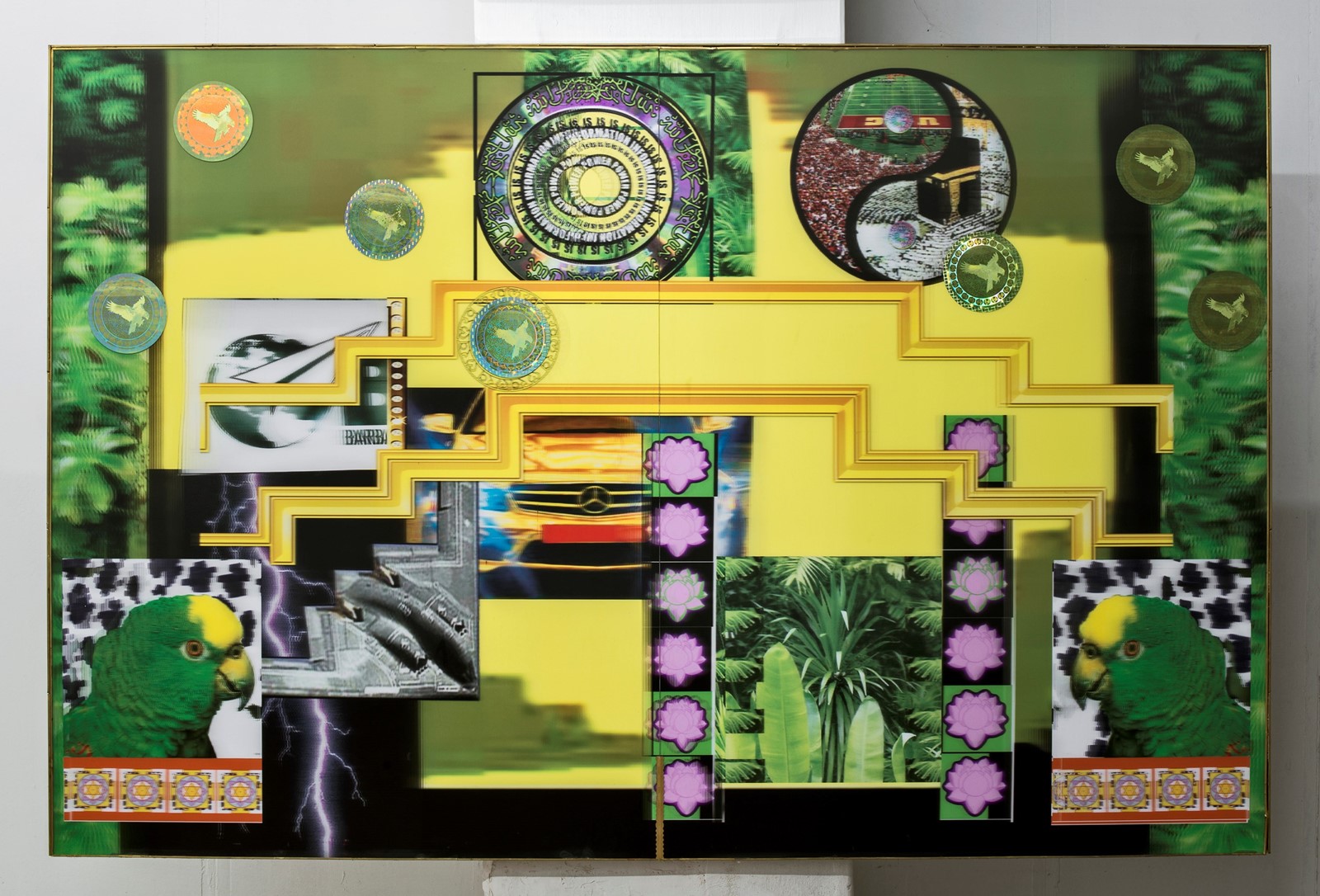According to Carri Munden, M.I.A. is “basically a human version of the internet”. The fashion stylist and new-rave architect had a hand in many of the looks that came to define the artist born Maya Arulpragasam’s early years, a pop smorgasbord blending insurrectionary street style, riotous colour and a whole menagerie of mismatching animal prints.
Arulpragasam got her break in the early 2000s, as the internet was becoming more a pervasive influence on people’s lives, something continually referenced in her music – from her breakout Piracy Funds Terrorism mixtape to the line about “pre-paid wireless” in her most famous song, Paper Planes.
But the internet looms large in Arulpragasam’s visual work, too. A fine art graduate from Central Saint Martins, M.I.A. blitzed traditional notions of taste with the brash DIY aesthetic of her album covers and videos for Sunshowers and Boyz, piecing together chaotic styles from across the globe. It’s a style that celebrated the weird levelling power of the internet, where space and time collapsed into a breadcrumb trail of clicked-on hyperlinks. “Tumblr before Tumblr,” Munden jokingly calls it, while Kochi-Muziris Biennale founding member Shwetal Patel, who helped commission Arulpragasam for the 2012 edition of the event, links her work to Nicolas Bourriaud’s concept of ‘altermodernity’, an artistic approach driven by the destabilising effects of the online realm.

“The internet now allows young people now to sample in building their identities,” says Munden, “and in the mid-00s in London that was exactly what was starting to happen.” As a native of Sri Lanka who had moved to the UK with no English at the age of ten, Arulpragasam was building more actively than most. For Steve Loveridge, a former classmate from Saint Martins whose documentary Matangi/Maya/M.I.A. is released this week, pop culture provided answers that the art world failed to offer.
“A lot of the art [we were exposed to at college] ended up in obscure galleries getting seen by boujie people with champagne glasses,” says Loveridge, a graphic designer who worked with M.I.A. on “two and a half” of her album covers (he claims he never got credit for the half). “It was like, ‘Nobody knows about this work, nobody’s gonna remember it.’ Whereas in [pop] culture there were things that did mean something to us, as a gay kid growing up in the suburbs and a Sri Lankan kid on a council estate. You end up looking for clues to who to be through television or magazines.”
It’s this search for clues which has powered Arulpragasam’s artistic journey to date, and which lies at the heart of Loveridge’s film, a pop-star origin story tracing M.I.A.’s roots back to a formative trip to Sri Lanka in 2001. But what role did Arulpragasam’s peerless eye have to play in her rise to fame? And how has it been influential on today’s crop of pop stars and visual artists? Below, Loveridge offers his take alongside a cast of M.I.A.’s friends and collaborators.
Fashion stylist Carri Munden on M.I.A.’s style...
“One of the first cover shoots we did together was for Dazed Japan around 2005; she took a chiffon Miu Miu dress I’d brought and immediately wrapped it around her head and body and made it into a hijab. She wore it with dirty Reeboks, big sunglasses and chains. That pretty much sums up her style, which has always been very DIY. She is true to herself and her style hasn’t changed.
“[Maya and I] are both drawn to certain colours, off-tones, patterns, visual overload, collage, symbolism, glitter and holographics – a kind of anti-graphic design and a clashing of stimulus… What we were doing visually was kind of Tumblr before Tumblr! Her use of digital technologies, animation, visual effects and film were crucial to her visual identity, too. And this aligns her with a generation of post-internet artists.
“The internet now allows young people now to sample in building their identities, and in the mid-00s in London that was exactly what was starting to happen. Cultural boundaries and subcultures were being bridged; there was an openness. That clash of cultures and disregard for boundaries, whether cultural, racial, gender-based or creative, was everything that Maya was about.”

Former manager Chris Taylor on how she is a cultural chameleon...
“Maya was looking a lot at the youth culture of London; she was very early on that idea. She used to hang out in Brick Lane before that was a trendy thing to do; it was very raw in those days. She was very into urban music, the bhangra [coming out of] the Pakistani and Bangladeshi and Indian communities there. The thing about Maya is she integrates into any situation really well – she could be hanging out with posh kids in west London, awkward-looking white people at Saint Martins or ghetto rappers in Portugal, and she’d never be judgy. She’s very good at transcending all these different environments, from red-carpet events like the Oscars to some ghetto studio where you can’t even see through the weed smoke.”

Curator Shwetal Patel on why M.I.A. is a living gesamtkunstwerk...
“Maya can be described as a kind of living gesamtkunstwerk, someone who has synthesised her practice to produce an all-embracing, total work. She has transcended her ethnic background in many ways, becoming a global pop star in the process, though there is also something intrinsically South Asian about her practice which we were interested in exploring through her participation [in the 2012 Biennale].
“Her first video, Sunshowers, was filmed in Kerala and there seemed to be lots of connections between her musical output, her background, the bright ‘in-your-face’ colours, interest in Hindu mythology, in particular the goddess Matangi, after whom she is named, and the region’s history.”
Director Steve Loveridge on why M.I.A. wouldn’t exist without the internet...
“Without the internet M.I.A. would never have happened, it was not only the way she started off – because MySpace and file sharing was how she and Diplo came up in the first place – but also it became a place where you could find out stories that weren’t in newspapers and stuff, so if she wanted to find out about Tamil issues or connect to different types of music it became this great place to harvest and research. You become used to receiving your information through that way of looking, so that bled into her art, because it was what your eye was receiving.
“I think Maya’s vision of what culture could be like was most completely realised on the Kala album. Using the new channels of communication that the internet offered, she showed an idea of a global ‘World Town’: file sharing, swapping ideas and defying cultural and geographical boundaries, kids all over the world celebrating and exchanging their creativity outside of giant corporations and economic barriers. Not living their whole lives glued to the internet – just using it as a way to swap resources and ideas and then have a party, outside, living real experiences. But I think that 12 years later the way we experience ‘taste’ online is not like that. I think the internet is still a very colonised space. It seems like a free and open thing, but actually I think it’s a very US-dominated and controlled environment, even aesthetically. I also think that US social justice ideas about race, that often only pertain to the specific clusterfuck of problems going on in that nation, have spread all over the world. They’ve promoted a very simplistic and un-nuanced idea of the evils of ‘cultural appropriation’ that is proving extremely reductive and unhelpful to art and culture worldwide, and making young people hate each other. I don’t think the Kala album and that ‘world town’ idea would even be acceptable online, now.”
MATANGI/MAYA/M.I.A. is in UK cinemas from September 21, 2018.
